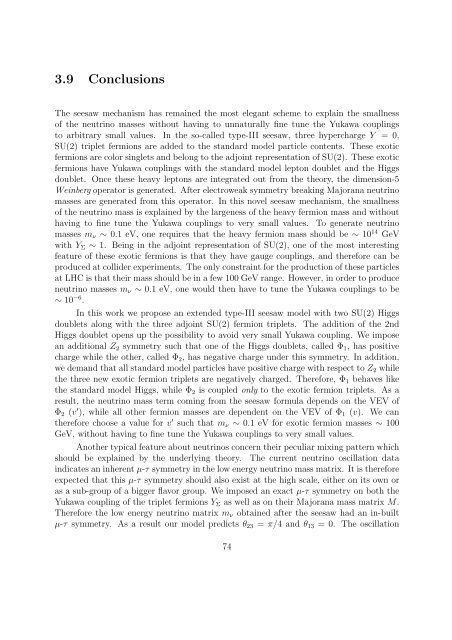PHYS08200604017 Manimala Mitra - Homi Bhabha National Institute
PHYS08200604017 Manimala Mitra - Homi Bhabha National Institute
PHYS08200604017 Manimala Mitra - Homi Bhabha National Institute
You also want an ePaper? Increase the reach of your titles
YUMPU automatically turns print PDFs into web optimized ePapers that Google loves.
3.9 Conclusions<br />
The seesaw mechanism has remained the most elegant scheme to explain the smallness<br />
of the neutrino masses without having to unnaturally fine tune the Yukawa couplings<br />
to arbitrary small values. In the so-called type-III seesaw, three hypercharge Y = 0,<br />
SU(2) triplet fermions are added to the standard model particle contents. These exotic<br />
fermions are color singlets and belong to the adjoint representation of SU(2). These exotic<br />
fermions have Yukawa couplings with the standard model lepton doublet and the Higgs<br />
doublet. Once these heavy leptons are integrated out from the theory, the dimension-5<br />
Weinberg operator is generated. After electroweak symmetry breaking Majorana neutrino<br />
masses are generated from this operator. In this novel seesaw mechanism, the smallness<br />
of the neutrino mass is explained by the largeness of the heavy fermion mass and without<br />
having to fine tune the Yukawa couplings to very small values. To generate neutrino<br />
masses m ν ∼ 0.1 eV, one requires that the heavy fermion mass should be ∼ 10 14 GeV<br />
with Y Σ ∼ 1. Being in the adjoint representation of SU(2), one of the most interesting<br />
feature of these exotic fermions is that they have gauge couplings, and therefore can be<br />
producedatcollider experiments. Theonlyconstraint fortheproductionoftheseparticles<br />
at LHCis that their mass should bein a few 100GeVrange. However, in order to produce<br />
neutrino masses m ν ∼ 0.1 eV, one would then have to tune the Yukawa couplings to be<br />
∼ 10 −6 .<br />
In this work we propose an extended type-III seesaw model with two SU(2) Higgs<br />
doublets along with the three adjoint SU(2) fermion triplets. The addition of the 2nd<br />
Higgs doublet opens up the possibility to avoid very small Yukawa coupling. We impose<br />
an additional Z 2 symmetry such that one of the Higgs doublets, called Φ 1 , has positive<br />
charge while the other, called Φ 2 , has negative charge under this symmetry. In addition,<br />
we demand that all standard model particles have positive charge with respect to Z 2 while<br />
the three new exotic fermion triplets are negatively charged. Therefore, Φ 1 behaves like<br />
the standard model Higgs, while Φ 2 is coupled only to the exotic fermion triplets. As a<br />
result, the neutrino mass term coming from the seesaw formula depends on the VEV of<br />
Φ 2 (v ′ ), while all other fermion masses are dependent on the VEV of Φ 1 (v). We can<br />
therefore choose a value for v ′ such that m ν ∼ 0.1 eV for exotic fermion masses ∼ 100<br />
GeV, without having to fine tune the Yukawa couplings to very small values.<br />
Another typical featureabout neutrinos concern their peculiar mixing pattern which<br />
should be explained by the underlying theory. The current neutrino oscillation data<br />
indicates aninherent µ-τ symmetry inthelowenergyneutrino massmatrix. Itistherefore<br />
expected that this µ-τ symmetry should also exist at the high scale, either on its own or<br />
as a sub-group of a bigger flavor group. We imposed an exact µ-τ symmetry on both the<br />
Yukawa coupling of the triplet fermions Y Σ as well as on their Majorana mass matrix M.<br />
Therefore the low energy neutrino matrix m ν obtained after the seesaw had an in-built<br />
µ-τ symmetry. As a result our model predicts θ 23 = π/4 and θ 13 = 0. The oscillation<br />
74
















